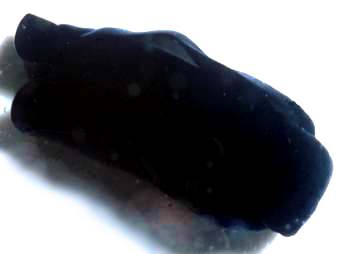
Melanochlamys cylindrica
Cheeseman, 1881
Order: CEPHALASPIDEA
Superfamily: PHILINOIDEA
Family: Aglajidae
DISTRIBUTION
New Zealand. [North & South Islands]
PHOTO
Auckland, New Zealand. Photo: Gary Batt.
The animal is totally black, sometimes with a bluish sheen when the light catches the beating cilia, which cover the skin, at a certain angle. In Cheeseman's (1881) original description of the genus Melanochlamys he differentiated the genus from Aglaja on the external form of the body noting that 'the side lobes of the foot [are] losely appressed to the sides of the animal, and [are] not spreading'. In live material it is possible to disnguish members of the genus by the shape of the body. It is usually cylindrical, the parapodia small and tightly held against the sides of the body. The posterior end of the head shield is rounded, sometimes with a median indentation, and held flat against the dorsal surface of the posterior shield over which it only just overlaps. There are no processes developed from the posterior end of the posterior shield, although there is usually a dorsal median indentation or notch. Melanochlamys cylindrica, like all members of the genus has a large muscular buccal bulb which fills the anterior half of the body cavity. It is a specific feeder on polychaete worms which it captures by rapidly sucking them in like a piece of spaghetti - the buccal bulb acting as a suction pump. Like most aglajids, it lacks a radula. It grows to about 30mm in length, and is usually found in algal turf on rock platforms.
References:
• Cheeseman, T.F. (1881) On a new genus of opisthobranchiate Mollusca. Transactions of the New Zealand Institute, 13: 224.
• Rudman, W.B. (1968) Three new species of the opisthobranch family Aglajidae from New Zealand. Transactions of the Royal Society of New Zealand (Zoology), 10(23): 211-216.
• Rudman, W. B. (1972) Structure and functioning on the gut of the Bullomorpha (Opisthobranchia). Part 4. Aglajidae. Journal of Natural History, 6(5): 547-560, 8 figs.
• Rudman, W.B. (1972) On Melanochlamys Cheeseman, 1881, a genus of the Aglajidae (Opisthobranchia: Gastropoda). Pacific Science, 26(1): 50-62, 8 figs.
• Rudman, W. B. (1972) Structure and functioning on the gut of the Bullomorpha (Opisthobranchia). Part 4. Aglajidae. Journal of Natural History, 6(5): 547-560, 8 figs.
Rudman, W.B., 2003 (May 11) Melanochlamys cylindrica Cheeseman, 1881. [In] Sea Slug Forum. Australian Museum, Sydney. Available from http://www.seaslugforum.net/find/melacyli
Related messages
Melanochlamys cylindrica from Whangaparaoa, New Zealand
July 27, 2009
From: Graham Bould
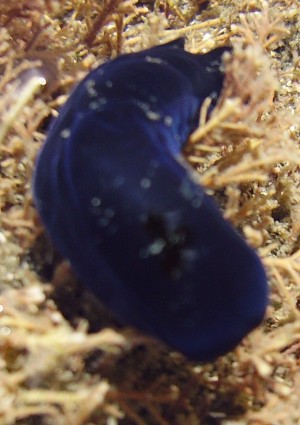
Dear Bill,
Here is a photo of unknown nudibranch for ID. Apologies for being out of focus. This is the only seaslug of this deep blue colour I have seen on this coast, although I have seen a number of similar slugs in plain black.
Locality: Rocks, Low tide level, Whangaparaoa, New Zealand, Pacific, 22 July 2009, On coralline growth in rock pool in full sun . Length: 30 mm. Photographer: Graham Bould.
Graham Bould
graham@grahambould.net
Bould, G., 2009 (Jul 27) Melanochlamys cylindrica from Whangaparaoa, New Zealand. [Message in] Sea Slug Forum. Australian Museum, Sydney. Available from http://www.seaslugforum.net/find/22589Dear Graham,
This is Melanochlamys cylindrica. It is not a nudibranch but a cephalaspid, which are a more primitive group of sea slugs which still have an internal shell. This species is found throughout New Zealand on both rocky and sandy mud shores. In northern New Zealand it is often found crawling over coralline turf where it is hunting for polychaete worms, which it eats by sucking them like a piece of spaghetti. Sometimes you will find Melanochlamys stuck with its head down in coralline turf at low tide in danger of drying out. What has happened is the worm it was sucking in was either to long or too quick, and was able to partially escape down a burrow at the base of the coralline turf. The slug refuses to give up - even thought it is danger of drying out - until it digests the bit of worm it has sucked in.
Best wishes,
Bill Rudman
Shell of Melanochlamys cylindrica
December 23, 2004
From: Bill Rudman
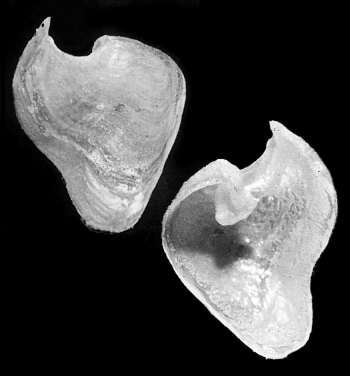
The Aglajidae are characterised by a reduced internal shell. In Melanochlamys the shell is still quite strongly calcified although as you can see here there are no complete whorls to the shell.
This shell is from a New Zealand species, Melanochlamys cylindrica, collected at Narrow Neck, Auckland, Waitemata Harbour, New Zealand, 1967. Shell dimensions: 6 x 5 mm. Photo: G. Batt.
Bill Rudman
Rudman, W.B., 2004 (Dec 23) Shell of Melanochlamys cylindrica. [Message in] Sea Slug Forum. Australian Museum, Sydney. Available from http://www.seaslugforum.net/find/12805Melanochlamys cylindrica from New Zealand
June 12, 2003
From: Paul Furneaux
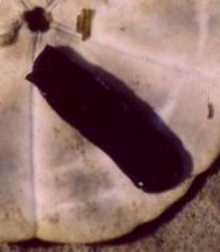
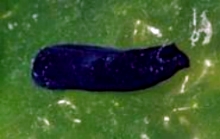
Hi Bill,
Here are the photos I promised of Melanochlamys cylindrica, the information that you posted on the Forum has been very helpful in identifying this one. This specimen was approximately 3cm long and I placed it on the Ulva and Sand Dollar to try to give some contrast to this rather difficult photographic subject. I counted 4 specimens on May 29th, and this was the first time that I had encountered them, although an increase in knowledge and experience has probably enhanced my observation skills. All four specimens were actively moving over the mud surface in shallow pools, and the location was in the same area of Tauranga Harbour, New Zealand that I have photographed both Philinopsis taronga and Haminoea zelandiae (mid to low - intertidal area of flats that contain extensive areas of Zostera and Ulva, off the Otumoetai Peninsula within the harbour.
I plan to try the polychaete worm test with them next time that I'm out.
Regards,
Paul Furneaux.
P.Furneaux@xtra.co.nz
Furneaux, P., 2003 (Jun 12) Melanochlamys cylindrica from New Zealand. [Message in] Sea Slug Forum. Australian Museum, Sydney. Available from http://www.seaslugforum.net/find/10196Dear Paul,
As you have discovered, the colour of this animal makes it almost impossible to photograph. Once you get a 'searching image' for it you will find it is also quite common at times on intertidal rock platforms, especially amongst coralline algal turf.
Best wishes,
Bill Rudman
Melanochlamys cylindrica from New Zealand
May 13, 2003
From: Bill Rudman

To accompany the question on Philinopsis taronga from New Zealand, I have prepared a page on Melanochlamys cylindrica, which is the most common aglajid in New Zealand, often occurring quite abundantly in algal turf on rock platforms. Although its shape and uniform black colour don't excite much interest, its spectacular feeding behaviour certainly does. It feeds on polychaete worms, which it captures and rapidly swallows whole, by sucking them in like a piee of spaghetti. It does this with a greatly enlarged and muscular buccal bulb, which through rapid expansion of the lumen creates a suction, rapidly drawing the worms through the buccal bulb into a large oesophageal crop where digestion takes place. Often when collecting Melanochlamys cylindrica you will find them stuck head down into the algal turf, almost impossible to extract. When you finally loosen them you will often find that they have part of a worm in their mouth. What happens is that when feeding they suck in part of a worm, but the other end is anchored firmly in a crevice or algal holdfast. In these cases, the slug doesn't let go but stays with its mouth losed until it digests the part of the worm it has inside. This an take 5 or 6 hours. At times when feeding animals in aquaria, 2 slugs would suck in the same worm simultaneously - from opposite ends. Physical laws being what they are, this would cause the slugs to hit heads as they sucked in their respective ends of the worm. neither would give way so they would sit head to head for several hours until digestion freed them from each other.
Best wishes,
Bill Rudman
